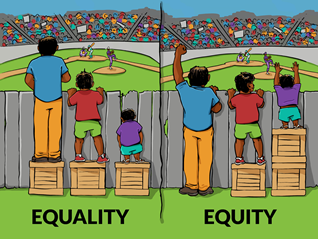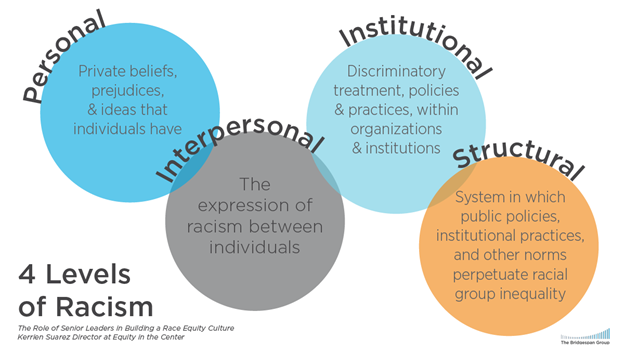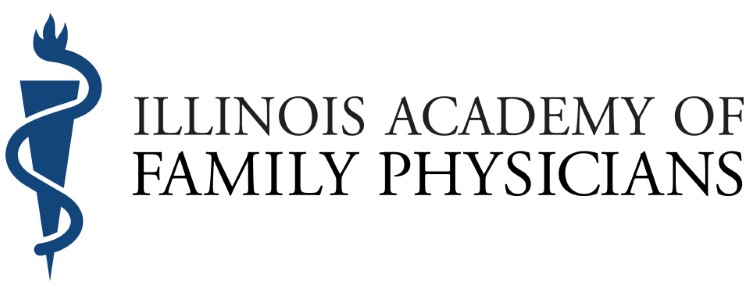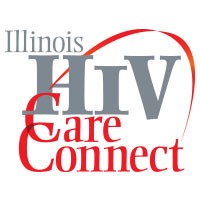Health Equity Resource Center
Jump to: Action, Provider Education, Illinois Resources, Practice Resources, LGBTQIA topics, Rural Health Equity, Definitions, Recommended Reading
Health Equity Member Interest Group Goals
Mission/Vision
Objectives:
- Support IAFP member needs related to education in health equity (e.g. implicit bias training, member activities and discussions)
- Create a network of IAFP physicians and students committed to health equity
Definition of Health Equity 
IAFP definition: Health equity is realized when each individual has a fair opportunity to achieve their full health potential. Achieving health equity requires treating everyone justly according to their circumstances: equality is an outcome of equity. Societal efforts must be undertaken to address structural inequalities that create group-differentiated access to resources, as well as differentiated vulnerabilities to harm.” (IHI, Healthy People 2020, Race Matters Institute, Structural Competency Workgroup, Am J Public Health)
Statement from the Editors of Family Medicine Journals (Oct. 15, 2020) includes a link to over 250 published manuscripts and demonstrates expertise as well as a commitment to addressing racism in medicine.
Definition of Racism:
“Americans believe in the reality of ‘race’ as a defined, indubitable feature of the natural world. Racism—the need to ascribe bone-deep features to people and then humiliate, reduce, and destroy them—inevitably follows from this inalterable condition. In this way, racism is rendered as the innocent daughter of Mother Nature, and one is left to deplore the Middle Passage or Trail of Tears the way one deplores an earthquake, a tornado, or any other phenomenon that can be cast as beyond the handiwork of men. But race is the child of racism, not the father.” (Ta Nehesi Coates, Between the World and Me)
To understand racism, one must understand how it operates on multiple levels: personal, interpersonal, institutional, structural. See the graphic below, and watch this video from RaceForward.

Ways to Take Action
Results from the IAFP's Health Equity Champions Survey highlighted 50+ individuals willing to partner with IAFP in a number of ways, and areas in which they want to get involved. We provide a brief overview of tangible ways to engage in health equity work.
Identify specific need from your personal experience, or community with the Illinois-Specific Resources below
Here are first steps you can take:
1. Reflect on existing biases and privileges you may bring to the table. This may be an uncomfortable reflection, but is part of the continual process. It is ok to make mistakes as long as you are humble.
2. Identify one socio-economic factor that may contribute to health inequity in your community. Think about stories from your patients, or use the resources here.
State and National Resources:
Use your Voice: Write an op-ed and/or Letter to the Editor:
Suggested places of distribution:
- AAFP Blog David Mitchell Social Media/Commentary Editor
- KevinMD
- Local newspapers (check the publication’s website for instructions on how to submit Letters to the Editor and Op-Ed and any word count limits)
- Doximity
Tips for writing an Op-Ed from the Harvard Communication Project
Make sure you have a headshot photo to submit, if needed.
You can also contact Ginnie Flynn, IAFP Vice President of Communications, for help in finalizing your message.
Diversity in Health Workforce
Illinois-Specific Resources
Purpose of this section: Direct audience to local resources for connection and potential partnership - this is where we would especially appreciate your experiences as a workgroup and knowledge of local resources and notable interdisciplinary partnerships to highlight
Illinois Specific Statistics on Health Disparities/Structural Inequity
Public Discussion
Practice-Based Resources
NowPow
Illinois Coalition for Immigrant and Refugee Rights (ICIRR)
AAFP and National Resources
Purpose of this section: Direct audience to concentrated list of select national resources, chosen based on variety of content and potential utility to audience
Social Determinants of Health (SDOH) Playbook - November 2023 from the White House
CMS Coverage to Care (C2C) resources for clinicians to share with patients in culturally appropriate formats and in several languages
CDC Conversations in Equity Blog
AAFP EveryONE Project Toolkit
- Implicit Bias Training
- Practice Leadership
- Assessment and Action (Screening and Action Plan Development)
- Community Collaboration
- Neighborhood Navigator
AAFP FPM Article September 2021 "How to Spot and Tactfully Address Discrimination in the Health Care Setting" written by IAFP members Santina Wheat, MD, MPH and Michelle Byrne, MD, MPH
AAFP FREE CME on Equity in Telemedicine (1.5 Credits)
STFM Health Equity: Goals and Resources
Structural Competency
NAMI - National Alliance on Mental Illness resource center on promoting culture and inclusion -
American Cancer Society Cancer Action Network (ACS CAN), Advancing Health Equity—Addressing Cancer Disparities Video
LGBTQIA Resources
The National LGBTQIA+ Health and Education Center (The Fenway Institute) Free and low-cost online and in-person training with CME on a full range of SGM Health Care
Howard Brown Health Center for Education Research and Advocacy - Chicago
Center of Excellence for Transgender Health Primary Care Protocols (UCSF)
Cancer in people who identify as LGBTQ or gender non-conforming (American Cancer Society Dec 2024)
Health Equity in Rural Health
Provide topic-specific opportunities at intersection of health equity and rural health, given unique landscape and practice of Illinois family physicians
Our Rural Health Equity Summit: August 2021 led to the creation of our Rural Health Equity Resource Center
Definitions of Health Equity
David R. Williams, PhD, MPH; Professor of Public Health at Harvard T.H. Chan School of Public Health:
Health equity, health disparity and health inequities are terms that are all used. Health equity is used to describe differences in health that are unfair and unjust.
Institute for Healthcare Improvement (IHI):
Health equity is realized when each individual has a fair opportunity to achieve their full health potential
World Health Organization (WHO):
Equity is the absence of avoidable, unfair, or remediable differences among groups of people, whether those groups are defined socially, economically, demographically, or geographically or by other means stratification.
"Health equity” or “equity in health” implies that ideally everyone should have a fair opportunity to attain their full health potential and that no one should be disadvantaged from achieving this potential.
Robert Wood Johnson Foundation:
Health equity means that everyone has a fair and just opportunity to be healthier.
This requires removing obstacles to health, such as poverty, discrimination and their consequences, including powerlessness and lack of access to good jobs with fair pay, quality education, and housing, safe environments and health care.
For the purposes of measurement, health equity means reducing and ultimately eliminating disparities in health and its determinants that adversely affect excluded or marginalized groups.
Paula Dressel, Race Matters Institute:
The route to achieving health equity will not be accomplished through treating everyone equally. It will be achieved by treating everyone justly according to their circumstances.
National Academy of Sciences:
Research shows that poverty, unemployment, low educational attainment, inadequate housing, lack of public transportation, exposure to violence, and neighborhood deterioration (social or physical) shape health and contribute to health inequities.
Boston Public Health Commission:
Health equity is the opportunity for everyone to attain his or her full health potential. This requires removing obstacles to health such as poverty, racism and other forms of discrimination, and resulting consequences, including lack of access to good jobs with fair pay, quality education and housing, safe environments, and health care.
American Public Health Association:
By health equity, we mean everyone has the opportunity to attain their highest level of health.
Inequities are created when barriers prevent individuals and communities from accessing these conditions and reaching their full potential. Inequities differ from health disparities, which are differences in health status between people related to social or demographic factors such as race, gender, income or geographic region. Health disparities are one way we can measure our progress toward achieving health equity.
Centers for Disease Control and Prevention (CDC):
Health equity is achieved when every person has the opportunity to “attain his or her full health potential” and no one is “disadvantaged from achieving this potential because of social position or other socially determined circumstances.” Health inequities are reflected in differences in length of life; quality of life; rates of disease, disability, and death; severity of disease; and access to treatment.
Healthy People 2020:
The attainment of the highest level of health for all people. Achieving health equity requires valuing everyone equally with focused and ongoing societal efforts to address avoidable inequalities, historical and contemporary injustices, and the elimination of health and health care disparities.
Recommended Reading/Viewing on Equity and Racism
From the Health Equity MIG Book Club
Medical Apartheid by Harriet Washington (click on the link for more information on where to purchase the book or check your local library for options)
County by Dr. David Ansell (Rush) about Cook County Health System's history
Recommended by Jen Nagel, Founder/Executive Director, The Porchlight Collective, SAP, Madison County, IL
THE DISPARITIES IN HEALTHCARE FOR BLACK WOMEN
By: Piraye Beim Posted on Jun 6, 2020
TRAUMA-SENSITIVE THEOLOGY
FOUR HUNDRED YEARS OF INEQUALITY TIMELINE
Impact and implications of the intersection of child welfare and criminal justice involvement on families.
OPPORTUNITIES FOR WHITE PEOPLE IN THE FIGHT FOR RACIAL JUSTICE
From AAFP's American Family Physician Journal
The COVID-19 pandemic and racial justice protests have brought new attention to long-standing race-based disparities in health outcomes. These online resources can help physicians become stronger advocates for change.
The 21-Day Racial Equity Habit Building Challenge: A program from Eddie Moore, PhD, that offers a template to structure learning on the subject.
Peggy McIntosh’s White Privilege Papers: Groundbreaking documents that describe McIntosh’s process for identifying her own privilege.
How to Identify, Understand, and Unlearn Implicit Bias in Patient Care: FPM article that provides a step-by-step method to identify and address bias.
In Focus: Reducing Racial Disparities in Health Care by Confronting Racism: Developed by the Commonwealth Fund, this overview of specific racial disparities in health care also discusses potential solutions.
AAFP FPM Article September 2021 "How to Spot and Tactfully Address Discrimination in the Health Care Setting" written by IAFP members Santina Wheat, MD, MPH and Michelle Byrne, MD, MPH
State of Health of Chicago (From Institute of Medicine of Chicago)
Framework for Equitable Allocation
Half of Chicago's households report serious financial problems during the COVID-19 pandemic, (Chicago Tribune 9.9.2020)
Breaking Silos and Taking Action: A Discussion about Black Maternal Child Health (Chicago Tribune 3.4.2020)
|





